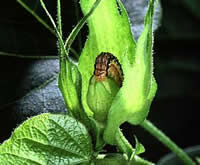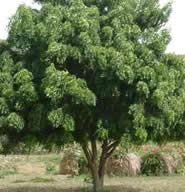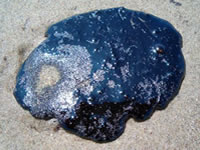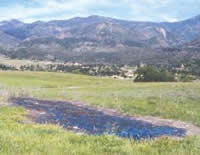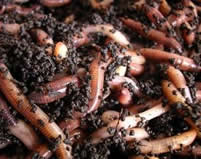|
|
 |
|
 |
Preamble. Whilst as an ex-organic grower I support natural agriculture, ie plants growing in living soil as nature intended, I am not entirely unsympathetic to the intelligent use of agrichemicals on a motivated case by case (as opposed to routine) basis, where consumers, including environmental health, are placed before profit and more importantly, risk-benefit analysis critically includes the safety of the whole produce itself from an endogenous plant defence, rather than merely the exogenous topical agrichemical defence perspective. Nutritional deficiencies and environmental stresses, including predaceous bugs and consequent fungal, bacterial and viral infections, can leave so-called “organic” produce far more toxic to human consumers as a consequence of inadequately protected plants systemically haphazardly producing their own defensive toxic chemicals, which unlike topically applied pesticides that biodegrade under the influence of sunlight, atmospheric oxygen and ambient temperatures, rather remain hazardous “inside” the plant produce until that produce itself decomposes. I have posted my treatise on this particular subject here. To many laypersons, the word “organic” means “natural”. However, to most well-read or educated persons with some knowledge of chemistry, “organic” means “carbon-based” or “carbon-containing”. Living things are comprised mostly of carbon compounds, so much of what is ‘organic’ to an ‘organic gardener’, is also ‘organic’ to an ‘organic chemist’, those who traditionally worked with substances synthesised within the cells or structures of organisms, dead or alive, but now legitimately include human laboratory synthesised substances from the same sources. |
|
(NB. If the caption ends
before being read, proceed to the previous or next photo and return
to the unfinished caption) |
| To exclude non-living sourced inorganic carbonates, cyanides, carbides, cyanates and carbon-containing ionic compounds from a definition of “organic compound”, this is specifically defined as compounds containing carbon, nearly bonded to itself and to hydrogen and often also to other elements. Human laboratory synthesised organic compounds may be copies of those occurring naturally: 100% nature-identical or variants thereof; or entirely novel compounds and like nature and money, range in utility from the most toxic and destructive to the most benign and beneficial, which spectrum describes both the natural kingdom and human endeavour. |
|
| Except for a few inorganic salts and water, everything you put into or onto your body, be it in past centuries or now - food, medicine, cosmetics and clothing all consists of organic compounds and are organic, but are not necessarily part of a modern marketing scam that claims to be “organic” or to have “organic certification”, when in fact it is only partly so, if at all. All certification companies, for commercial expediency, have deliberate, if not fraudulent, but always seriously compromised standards allowing inorganic, human-processed and even human-synthesised chemicals, besides only requiring varying proportions of strict organic content, which itself is always compromised to start with. |
| In scientific terms, “organic” is defined as: “Pertaining to carbon-based compounds produced by living plants, animals or by (human laboratory) synthetic processes” and a layperson’s alternative meaning is: “Any produce grown without the use of chemical fertilisers or pesticides, in soil made rich by composting” (biology-online.org). Another legitimate meaning includes the even longer established scientific use: “Of, relating to, or affecting a bodily organ” (chemheritage.org). Further popular meanings include: “Having properties associated with living organisms”; “Resembling a living organism in organisation”; “Interconnected”; and “Constituting an integral part of a whole”. Clearly the word “organic” is exclusive to no-one. |
|
I, Stuart
Thomson, formulate and manufacture my own natural personal
care products under the trade name "Gaia Organics",
for which I was, a decade ago, granted provisional approval of the
trademark “Gaia Organics”, with the proviso that the
words not be used separately and apart from the mark, which registration
remains incomplete due only to Unilever’s
opposition thereto in its ridiculous attempt to register the single
word “organics” as its exclusive trademark. I use the
word ‘organics’ in the trade name based
on perfectly legitimate associations with all the above-listed meanings,
without in any way suggesting that my products are “certified
organic”, which has a clearly circumscribed meaning, albeit
nonsensical and hypocritical. |
|
In terms of commercial law: “The word ‘organic’ in a ‘brand name’ does not inherently imply an organic production claim and thus does not inherently constitute a false or misleading statement" (US National Organic Program/Standards/Labelling -- Preamble/General Requirements). Quite to the contrary, I publicly criticise organic standards as irrational and organic certification as a scam here and also here, and in particular the latter as it relates to organic ingredients from the former and constituting so-called “organic” products. “Certification” criteria are entirely arbitrary, not only between certification bodies (there is no single standard), but also amongst members, many of whom comply with or pay lip-service to such standards purely as a marketing strategy, with the intention of conning consumers to purchase their (rather than another’s) products”. |
| |
According
to Valerie Lemaire, Certification Manager for the
commercial company, Ecocert: “The objective
of the Standard is to valorise (add value to) the ingredients from
Organic Farming and require the use of ingredients from
agro-resources rather than from petrochemistry”
(Ecocert Certification, Society of
Cosmetic Chemists, California Meeting, 22 May 2007).
Ecocert, defines “synthetic”
as: “Manufactured by a chemical process or by
a process that chemically alters compounds extracted from naturally
occurring plant, animal or mineral sources”,
yet this is precisely what many certified organic proprietary
products are. Furthermore, avoidance of known human laboratory
synthesised pesticides forces plants to synthesise considerable
quantities of largely untested defensive pesticidal toxins (see
here),
which unlike laboratory formulations, only degrade on eventual decomposition
of the plants themselves. |
| |
Just
because something is produced by nature, does not make it safer
to ingest or apply to your skin. For example, Cottonseed
oil contains Gossypol; a toxin that causes pathological
changes in human testes and male sterility (Coutinho
E, Contraception, 65(4), 2002) and is a potent initiator
and promoter of skin carcinogenesis (Haroz
R, Thomasson J, Toxicol Lett, Suppl 6(72), 1980). Crude
unrefined cottonseed oil contains up to 750mg/100ml of gossypol
and its toxicity is due to its oxidative production of free radicals
(Coburn M et al, Biol Bull, Woods
Hole Mass, 159(468), 1980). Gossypol protects the cotton
plant from pests (Puckhaber L et
al, J Agric Food Chem, 50(24), 2002). Correctly "processed",
cottonseed oil produces less photocarcinogenesis than sunflower
seed oil and is not an irritant / sensitiser (Final
Report on the Safety Assessment of Cottonseed Oil, Int J Toxicol,
20(Suppl 2:21-9, 2001). |
|
| Professor
Steven Ley of Cambridge University and colleagues, including 40
PhD students have laboured for more than two decades to effect a
total synthesis of the natural insecticide azadirachtin. This hugely
complex natural product was first extracted from the Indian Neem
tree in 1968. Ley's team have published their 64-step total synthesis
(Ley S et al, Angewandte Chemie,
46(34), 2007). Should the nature-identical human-synthesised
version now be shunned merely because it is laboratory synthesised
from ancient biomass rather than by contemporary biomass? The former
even frees up the latter for critical Indian food-purposes, but
organic standards are obliged to disallow it, due to corny stubborn
philosophical bias against a perfectly natural organic petrochemical
feedstock and human ingenuity. |
|
| A
substance behaves or reacts the way it does because of the atoms
its molecules are made of and how they are combined. Carbon-based
compounds behave differently from those based on other elements.
It is logical to group carbon-based compounds together based on
chemical and behavioural similarity and there is no reason to separate
natural from synthetic compounds. If two molecules are made of the
exact same atoms combined in the exact same way, they are going
to behave in the exact same way, irrespective of whether one was
made by living organisms and another was made “nature identical”
from living or non-living elements by a chemist in a laboratory.
This assumes that the target compound is simple enough to synthesise.
Nature is often far too complex to copy. |
|
| The
word “organic” has a biological connotation
arising from a major misconception that stifled research into the
chemistry of living things for many decades. In the early 19th century,
many prominent thinkers believed that an observable spiritual energy,
a “vital force”, existed within the
compounds of living things, making it fundamentally different from
compounds of the mineral world and impossible to synthesise. Vitalism
was definitively challenged and defeated when Friedrich
Wöhler in 1928 heated ammonium cyanate, a mineral
world compound and produced urea, a living world compound, without
the need of a kidney and soon other organic compounds from inorganic
sources were synthesised. (Silberg
M, Chemistry: The Molecular Nature of Matter and Change, McGraw-Hill,
2000) |
|
| CRUDE OIL / PETROLEUM The South African Agricultural Product Standards Act, 1990, correctly defines “organic compounds” as: “containing carbon combined with hydrogen and often with oxygen and other elements”. Irrespective of whether one subscribes to the biotic or even the abiotic origins hypothesis, crude oil is, by any definition, “organic”, yet the arbitrary, non-scientific, indeed nonsensical and hypocritical organic standards exclude it, for no reason other than self-serving double standards. Most substances from plants and/or animals are comprised of water, which is not organic. No product containing water can therefore be 100% organic. Petroleum crude oil, on the other hand, is mostly carbon and hydrogen, is therefore organic and hence can technically be certified 100% organic straight out of the ground. |
|
| I am not suggesting that we use crude oil as fertiliser (it is nevertheless feasible), but it is necessary to understand that it is a perfectly natural and organic resource and it is not itself a threat, though our misuse of it is can be. Petroleum existed long before humans developed the technological ability to retrieve it from the earth and use it as a source of energy. Natural seeps have been releasing hydrocarbons for thousands of years, creating ecosystems with adaptive micro-organisms that utilise petroleum effectively. Clearly (accidental) inputs of petroleum hydrocarbons have the potential for significant environmental impacts (more because of volumes involved than any significant toxicity), but the effects of chronic low-level discharges can be minimised by the net assimilative capacities of many ecosystems, resulting in little detectable environmental harm. (Overton E, Sharp W & Roberts P, Toxicity of Petroleum, Ch 5, in Cockerham L & Shane B, Basic Environmental Toxicology, CRC Press, 1994)
The “OECD-Earthworm Toxicity Test” (ISO 11268-1/2) is a terrestrial ecotoxicological test of effects of chemicals on soil fauna. Earthworms are used because of their function as sensitive decomposers and high biomass in soil. The “compost worm” Eisenia fetida (Lumbricidae) was used to test three levels of crude oil contaminated soil from an oil refinery site deemed mandatory for remediation from an oil refinery site. The tests determined that: a) no significant acute toxic effect could be observed, even at the heaviest levels; b) only the heaviest level was reproductively toxic; c) only in the heavier and heaviest levels did worms lose biomass (10%), whereas at the lower levels, worms actually increased their biomass by 20%; and d) only the heaviest levels elicited avoidance responses. Hydrocarbon concentrations of the different test substrates with worms were reduced between 60 - 90%. As Earthworms increase the metabolic activity of soil micro-organisms, this leads to an enhanced degradation of the mineral oil compounds, supporting bioremediation. (Schaefer M, “Earthworms in Crude Oil Contaminated Soils: Toxicity Tests and Effects on Crude Oil Degradation”, Special International Issue, Soil Sediment & Water [Assoc Environ Health Sci], August 2001)
In what was one of the “hottest articles” of this period, by an expert in this field, the earthworm species Eisenia fetida and Lumbricus terrestris were incubated in crude oil polluted soil [10,000 mg/kg total petroleum hydrocarbons (TPH)]. In the oil-contaminated soil, respiration and concentration of microbial biomass was significantly enhanced by earthworm amendment, and TPH concentrations decreased significantly. (Schaefer M, et al, Soil Biol Biochem, 37(11), 2005) The same species were used to determine whether earthworms could enhance the degradation of aged crude oil in soil from an old oil refinery site. It was established that in heavily contaminated soil (9500 mg total petroleum hydrocarbons (TPH)/kg soil dry wt), there was a significant decrease in TPH concentration, indicating earthworm stimulated microbial degradation. Furthermore, added organic matter did not necessarily enhance this bioremediation. Earthworms can be useful for in situ soil bioremediation when TPH concentrations are moderate, hence non-lethal (<4000 mg/kg), even of highly contaminated sites, when TPH and potential toxicity have been decreased to a tolerable level. (Schaefer M, Filser J, Applied Soil Ecology, 36(1), 2007)
Only a few generations ago, oil for lubrication, nutrition and medicine was pressed from plant crops or rendered from animal fat. Crude oil, also known as petroleum (“petro” meaning “rock” and “oleum” meaning “oil”), first presented to humans as natural seepage to the surface on land and blobs floating ashore, both originating from sediments of natural organic matter laid down over hundreds of thousand of years, millions of years ago. Formed from the remains of living things in anaerobic microbial conditions underground as kerogen (insoluble algal/woody matter) it matured into an assortment of hydrocarbon molecules, the lightest, natural gas and the heavier, crude oil. When first tapped to depth in 1859, its virtues began to be discovered and over a century transformed civilisation. |
|||
|
|||
|
The most common petroleum reservoir is a stratigraphic trap, possibly
with a layer of natural gas on top of the oil. Petroleum
is called a fossil fuel, but contains no fossils.
There are chemical fossils - biological chemicals that did not evolve
until more recently, in younger oils – but actual fossil material
occurs only in the youngest kerogen. Crude oil is a natural
earth produced concentrate of the remains of ancient vegetation
esp. algae (not unlike current bio-fuel feedstock), plankton and
in particular diatoms (single-celled marine and freshwater photosynthetic
organisms, the exoskeletal remains of which are permitted by organic
double-standards). Crude oil is in fact pure organic “liquid
bio-geologic compost”. The only reason for the organic
movement’s rejection of the whole or selected components of
this perfectly natural resource is that it is a competitive impediment
to its own backward existence. |
|
|
Plants and algae use photosynthesis to fix atmospheric carbon dioxide
into organic forms of carbon, which become the basis for our biosphere,
for all life. The crude oil in use today originated from
solar energy synthesised by organic life hundreds of millions of
years ago. At source,
it remains uncontaminated by the products of any human activity,
rendering it infinitely more natural and purely organic than any
alternative currently or in future available anywhere else on our
planet. Whilst I do agree that, as with contemporary biomass,
this resource should not be squandered on wasteful inefficient energy
combustion, it is nevertheless totally hypocritical to condemn its
use in chemistry, which includes personal care, while we all benefit
daily from a myriad of its modern technological uses. |
|
|
When ancient biomass died, it either decomposed and was broken down
into carbon dioxide and water or was buried beneath layers of sediment,
putting it under pressure and heat, causing the organic matter to
break down and create kerogen and bitumen. In a process called cracking,
larger organic molecules broke down into simpler molecules, hundreds
of meters down in the earth and then moved through rock and settled
into reservoirs creating oil pools, several of which make up an
oil field. The rate at which it migrates at is generally up to 1000
kilometres per million years, depending on several factors including
the amount of pressure and the permeability of the rock. The amount
of time that this takes from start to finish is generally considered
to be in the range of millions of years.
While a few renegade Russian-Ukrainian geologists believe that petroleum has an inorganic origin, the by far majority position, is of a biogenic organic origin, millions of years ago under strong reducing (anaerobic) conditions from a combination of hydrocarbons synthesised by living organisms and/or by thermal alteration of organic matter, whereas coal was formed from woody land plant debris decaying under mildly reducing (some oxygen) conditions. Burial to temperatures of 50-90°C caused thermocatalytic reactions in Kerogen, resulting in the main constituents of crude oil being generated and matured. It is nature’s most precious gift, made in its own laboratory and as opposed to harvesting current biomass as feedstock for organic agriculture, takes no life as sacrifice for our usage. |
|
|
|
Chemical fossils (biomarkers) are molecules in crude oils, whose
carbon structures can be traced back to living organisms. These
organic compounds, unequivocally related to their natural product
precursors, originated from chemical/geological transformation of
biomolecules of organisms deposited during sedimentary processes.
Within the stable carbon-carbon structure of such compounds are
embodied essential information on the habitat, nature and fate of
the ancestral flora and fauna deposition of ancient sediments and
petroleum. The most relevant geochemical criteria reflect the genetic
relationships between organic matter at different levels in the
stratigraphic column. (Hunt J, Petroleum
Geochemistry and Geology, WH Freeman & Co, 1996)
Typical chemical fossils include the terpenoids (eg, pristane, phytane & hopane); the porphyrins (eg, chlorophyll) and the paraffin carbon chains. The nature of the organic matter and the redox potential in the depositional environment during early diagenesis of the main precursor of phytane and pristane, i.e., chlorophyll, or specifically its phytol chain, is generally reflected by the ratio of Pristane to Phytane. The evaluation of the n-alkane distribution is a standard method of classifying oils and rocks according to whether terrestrially or marine-derived organic matter predominates in the source rock. The Carbon Preference Index and the Odd/Even Carbon Ratio are both commonly used as a measure of maturity of organic matter. (Osuji L, Anita B, J Appl Sci Enviro Mgt, 9(1), 2005) |
|
|
|
The abiogenic theory thrived over a period in which
scientific knowledge in biology, geology, and chemistry was in the
dark ages. Mendeleyev, Kudryavtsev and Porfirev's abiotic evidences
was accepted at the beginning and in the mid-20th century because
it offered an explanation for the presence of petroleum deposits
in metamorphic rocks of the basement. With the advances of analytical
chemistry, around the 1950’s, geochemical evidence suggested,
and latter proved that oils are related to biological precursors
(Forsman & Hunt, 1958; Eglinton
& Calvin, 1967 and Tissot, 1969). In the late seventies
Albrecht, Seifert, Moldowan and Maxwell definitively proved the
relationship between hydrocarbons and their putative biological
precursor, burying the abiogenic hypothesis forever. (Mello
2005)
Today, the biogenic theory, that all petroleum
is derived from biological precursors, is well proved and supported
by laboratory experiments. Petroleum composition is shown to reflect
that of oil generated from kerogen by pyrolysis.
The application of high resolution biomarker technologies, integrated
with detailed geological and paleontological characterization,
provide scientific evidence that oils can be attributed to organic-rich
sedimentary rocks of specific geological age and depositional
environments. Present-day
analysis, when integrated with direct geochemistry,
remote sensing and high resolution geochemistry technology, can
provide irrefutable proof that 99.99999% of all the oil and natural
gas accumulations found up to now in the planet earth have a biologic
origin. (Mello
M and Moldowan J, Petroleum: To Be Or Not To Be Abiogenic, Abstr
90043, Amer Assoc Petrol Geol, 2005) |
|
|
|
The biogenic paradigm
is overwhelmingly convincing, some aspects of which I shall mention
to illustrate this:
|
||
| General
References Pertaining to the Organic Origins of Crude Oil (Russell W, Principles of Petroleum Geology, McGraw-Hill, 1960) (Levorsen A, Geology of Petroleum, WH Freeman & Co., 1967) (Hills I et al, J Inst Petroleum, 56:127, 1970) (Tissot B et al, Amer Assoc Petrol Geol Bull, 8:499, 1974) (Staplin F, Sedimentary organic matter, organic metamorphism and oil and gas occurrence, Canad Petrol Geol Bull, 19(1), 1979) (Tissot B, Welte D, Petroleum Formation and Occurrence, Springer-Verlag, 1984) (Simoneit B, Cyclic terpenoids of the geosphere, In R Johns (Ed.), Biological Markers in the Sedimentary Record, Elsevier Science, 1986) (Tegelaar E et al, Possible origin of n-alkanes in high-wax crude oils, Nature, 342(6249), 1989) (Moldowan J, Albrecht P & Philp P (Eds), Biological Markers in Sediments and Petroleum, Prentice – Hall, 1992) (De Leeuw J & Largeau C, A review of the major classes of organic compounds that comprise living organisms and the pathways for their incorporation into sediments, In: Engel M & Macko S (Eds), Organic Geochemistry, Plenum NY, 1993) (Krauskopf K, Bird D, Introduction to geochemistry, McGraw-Hill, 1995) (Brownlow A, Geochemistry, Prentice Hall, 1979) (Dahl J et al, Diamondoid hydrocarbons as indicators of natural oil cracking: Nature, 399:54-57, 1999) (Toro J, "Origin of Petroleum", Lecture Notes, Geology 472, West Virginia University, Spring 2005) (Peters K et al, The Biomarker Guide, Cambridge University Press, Vol. 1, 2005 / Vol.2, 2007) |
||
 |
 |
|
(Hover cursor over the photos for caption) |
||
| “Paraffin” is the common name for high molecular weight aliphatic components of crude oil. The meaning of the Latin “paraffin”, which puts the fear of God into ignoramuses is simply “without affinity”. It is approved by the USDA Organic Standards, including for topical application in animal husbandry for human consumption. It is alternatively known as mineral oil, a term used by Gaia to differentiate it from illuminating paraffin, a high energy fuel which has flammable compounds added and is known locally just as paraffin. White mineral oil/white liquid paraffin is the highest possible cosmetic-, pharmaceutical- and food-grade of inert material, which is the international standard base lipidic material used in the formulation the finest, most elite personal care products and cosmetics available. | ||
| Fanatical organic proponents avoiding these pure natural organic resources on flawed philosophical propaganda might do well to evaluate the fraud perpetrated by those demonising such resources for commercial expediency against the false concept of nature’s assumed benevolence and appropriately engage in some risk/benefit analysis by honestly comparing the above information primer and photographic essay, with a few closing photographs. If you get the point, and especially if you don’t,, please explore the links below to hopefully reverse your irritating and often nauseating brainwashing. |
||
 |
 |

|
(Hover cursor over the photos for caption) |
||
| |
||
|
||
| |
||
|
Gaia is copyright © 2006 Gaia all rights
reserved Designed by Webs The Way |
||
|
Page Counter as of January 2008 |




